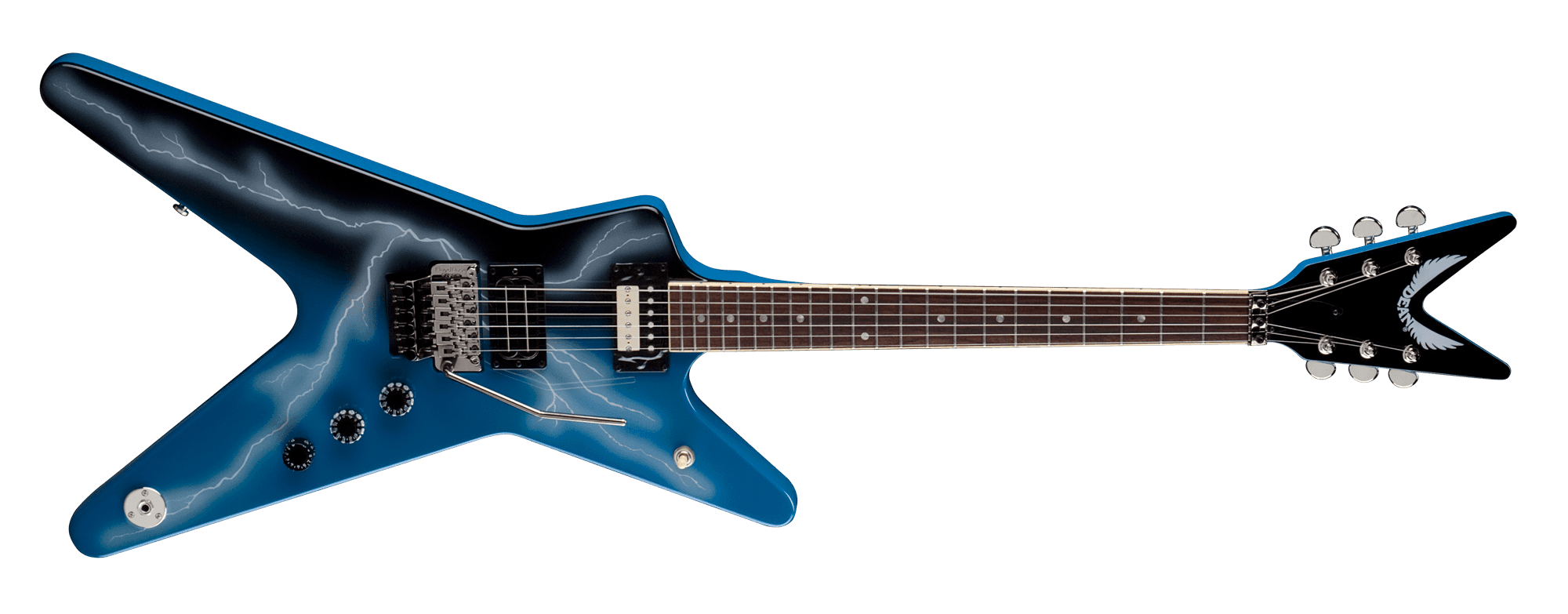 This case concerns the alleged copyright infringement of a lightning storm graphic that originally appeared on the guitar of Darrell Abbott, late guitarist of the heavy-metal band Pantera.
This case concerns the alleged copyright infringement of a lightning storm graphic that originally appeared on the guitar of Darrell Abbott, late guitarist of the heavy-metal band Pantera.
Buddy Webster is a guitar maker and technician who goes by the name “Buddy Blaze.” In 1985, he modified a Dean ML guitar, produced by Dean, and paid someone to paint a lightning storm graphic on the guitar. In 1987, Webster gave the guitar to his friend Darrell Abbott.
Abbott later became a successful guitarist in the band Pantera. Abbott called the guitar “The Dean from Hell” (DFH). In 2004, Abbott entered an endorsement-type contract with Dean. But in December of that year, he was shot and murdered on stage by a deranged fan.
Around the time of Abbott’s death, Dean started selling reissues of the DFH guitar. Webster first learned about the sales of the reissues in December 2004. Dean never asked Webster for his permission to sell the reissues, and Webster never approved of the sales.
In 2006, Webster learned that Dean was selling a cheaper, imported version of the DFH called the Cowboy from Hell. Webster was unhappy that Dean was selling these two versions of the DFH, so, in 2006, he emailed then CEO of Dean, Elliot Rubinson, and expressed his displeasure. Webster told Rubinson that Dean could not sell the reissues without his permission; Dean did not stop selling the guitars.
From 2009 to 2015, Dean released several other versions of the DFH. In 2009, Webster learned that Dean was marketing and selling a new version of the DFH known as the “Rust from Hell.” Dean then released a guitar featuring the lightning storm graphic called the “Black Bolt.”
Finally, in 2015, Dean issued the “Limited USA Dean from Hell.” Webster claimed that he “had finally had enough” at this point, and, in 2016, he retained counsel and obtained a copyright registration in the lightning storm graphic.
In April 2017, Webster filed suit against Dean and several others. The court decided that Webster’s copyright infringement claim was time-barred because the claim accrued more than three years before Webster filed suit. In doing so, the court first concluded that the “gravamen” of Webster’s claim of copyright infringement was ownership. The appeal followed.
Webster raised several challenges to the district court’s decision that his copyright claim is time-barred. First, he argued that the court erred when it concluded that the gravamen of his copyright claim was ownership, because he had registered his copyright in the lightning storm graphic and the Appellees did not dispute his ownership in a counterclaim or affirmative defense.
Second, he asserted that copyright ownership claims do not have a different accrual date than copyright infringement claims and that an infringement claim accrued each time Dean reproduced the lightning storm graphic. Alternatively, he argued that his claim survives summary judgment even if a separate accrual standard applies because he had no reason to know that his ownership claim had accrued.
The Sixth and Ninth Circuits have held that a copyright ownership claim accrues when “there is a ‘plain and express repudiation’ of ownership by one party as against the other.” The First, Second, Fifth, and Seventh Circuits have held that copyright ownership claims accrue “when the plaintiff learns, or should as a reasonable person have learned, that the defendant was violating his rights.”
Additionally, at least one circuit has held that “where the gravamen of a copyright infringement suit is ownership, and a freestanding ownership claim would be time-barred, any infringement claims are also barred.” The district court properly concluded that Webster’s copyright claim was time-barred. To begin, the court properly characterized Webster’s claim as one primarily concerning copyright ownership.
Webster’s main argument is that he owns the lightning storm graphic and the Appellees have reproduced it without his consent. The parties agree that Dean has reproduced the graphic on several guitar models without Webster’s permission, leaving ownership the only disputed issue.
Further the Appellees raised as an affirmative defense the statute of limitations, asserting that Abbott’s estate clearly and expressly repudiated Webster’s copyright ownership in the lightning storm graphic in 2007.
Additionally, Webster’s copyright registration does not entitle him to a presumption that his copyright is valid, given that he registered the graphic in 2016 – about 30 years after the original DFH was created. Therefore, the court correctly determined that the gravamen of the case is ownership.
The appeal adopted the approach used by the First, Second, Fifth, and Seventh Circuits. Thus, Webster’s copyright ownership claim accrued when he knew, or reasonably should have known, that his ownership rights in the lightning storm graphic were being violated.
Webster had reason to know that his alleged ownership rights were being violated as early as 2004, when he first learned that Dean was producing DFH reissues. But if that were not sufficient to put him on notice that his rights were being violated, Rubinson’s email in 2007 stating that “the consensus concerning the lightning storm graphic is that Abbott’s estate is the legal owner of it” was certainly sufficient.
Therefore, Webster’s claim accrued in April 2007 at the latest, and the three-year limitation period expired years before he brought his copyright claim in 2017. Moreover, to the extent that Webster asserts a separate copyright infringement claim, that claim is also barred. The appeal affirmed the district court’s grant of summary judgment in favor of the Appellees on Webster’s copyright claim.